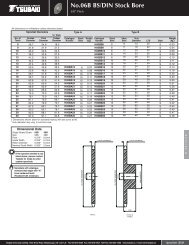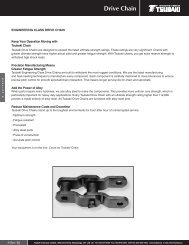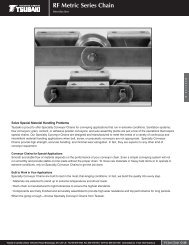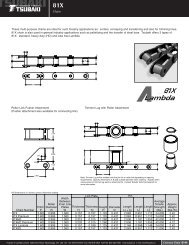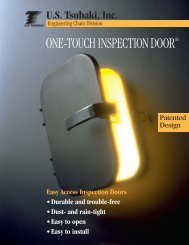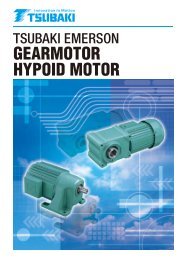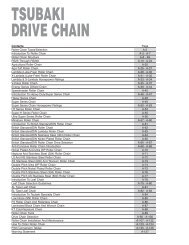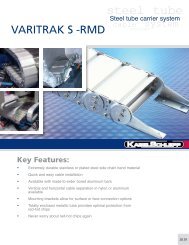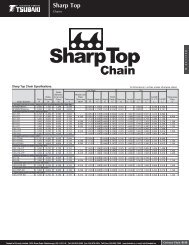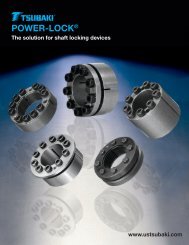DRIVE CHAINS - Tsubaki
DRIVE CHAINS - Tsubaki
DRIVE CHAINS - Tsubaki
You also want an ePaper? Increase the reach of your titles
YUMPU automatically turns print PDFs into web optimized ePapers that Google loves.
Handling of roller chain and sprocket4. Layout and Installation of Roller Chain4.1 Speed ratio and chain lapA roller chain transmission speed ratio up to 7:1 is normallysuitable; however, at very slow speeds a ratio upto about 10:1 is possible. The chain lap between thesmall sprocket and chain must be 120° or more. Forlifting applications, the angle must be 90° or more.Fig. 13: Chain lapLifting application4.2 Distance between shaftsThe minimum distance can be as short as desired aslong as the teeth of the two sprockets are not in contact.The optimum center-to-center distance betweenthe shafts is 30 to 50 times the pitch of the roller chain.However, if the load is variable, a distance of 20 timesor less is suitable.4.3 Amount of slack1) Unlike V or flat-belt transmission, there is no need to applyan initial tension in roller chain transmission; rollerchain is normally used with a suitable amount of slack.If too much tension is applied to roller chain, the oil filmbetween the pins and bushes will be broken, causingincreased wear and damage on the roller chain andbearings. If there is too much slack in the roller chain,the chain will vibrate and ride up the sprocket,damaging both chain and sprocket.2)If possible, the lower side should be the slack side in rollerchain transmission. The amount of slack is appropriatewhen the distance (SS') that the chain can be moved perpendicularlyby hand at the center of the slack side is 4% ofthe span (AB). (For example, when the span is 800 mm, theamount of slack should be 800 mm x 0.04 = 32 mm.)In the following situations, this should be 2%:1) When the transmission is vertical or close to vertical(a tensioner is required).2) When the distance between the shafts is morethan 1 m.3) When frequent starts are made with a heavy load.4) When sudden reverse motion takes place.SpanFig. 14: Amount of slack3) Roller chain will stretch slightly during the first few dozenhours of use as the contact surfaces wear in (about0.05%). This may result in too much slack in the rollerchain and may require adjustment of the slack.A tensioner can be used if the layout is designed for it. Ifyou do not have a tensioner, move the shafts to adjustthe amount of slack. Once the chain is worn-in, very littlestretching will occur.4.4 Horizon precision and parallelism of the shaftsThe installation precision of the sprocket has a largeeffect on the smoothness of roller chain transmission.It also affects roller chain life.Install the sprockets correctly as described below.1) Verify Horizontal precision with a level.Adjust the precision to within ±1/300.Level gaugeFig. 15: Horizontal precision2) Use a scale to correct the degree of parallelism ofthe shafts.Adjust the shafts so that they are parallel to within±1/300 = (A-B/L).Before Use For Safe Use Standard Roller Chains Lube-Free Roller Chains Heavy Duty Roller Chains Corrosion Resistant Roller Chains Specialty Roller Chains Accessories Selection HandlingFig. 16: Degree of parallelism of the shafts162



